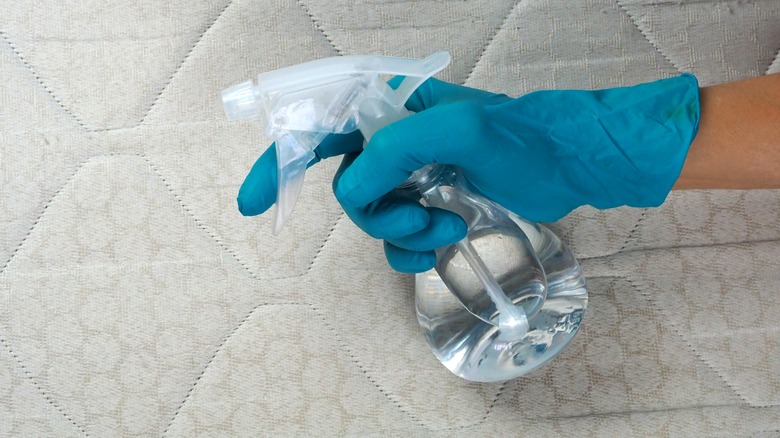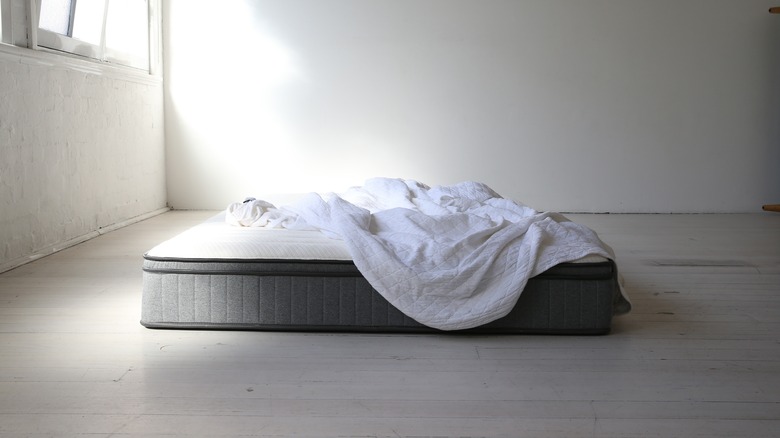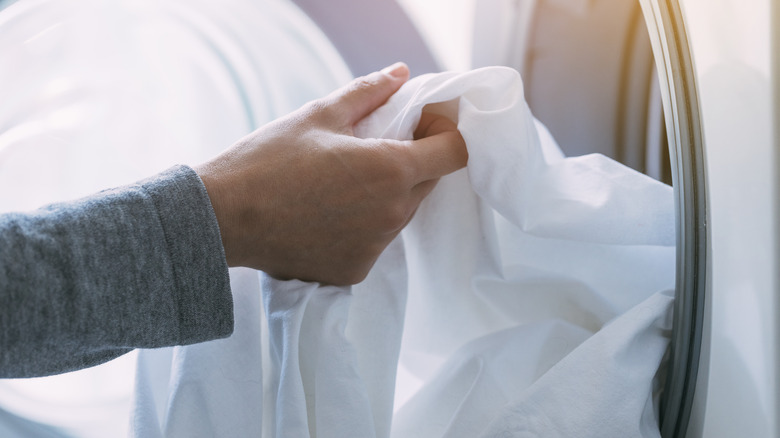Why People Are Spritzing Their Mattresses With Hydrogen Peroxide (& Should You?)
Cleaning your mattress probably isn't usually at the top of your list of chores. But they can accumulate all kinds of allergens over time, and just because you can't see them doesn't mean they're not affecting your health. Dust mites are one of the most common, and some people have turned to hydrogen peroxide as a quick fix. But if reducing these arthropods is your priority, there are better ways to do so.
Even if the rest of your house is squeaky clean, chances are high that you have dust mites in your mattress. "You can't see dust mites with the naked eye," Dr. Tania Elliott MD, dual board certified doctor in Internal Medicine and Allergy/Immunology, and spokesperson for the American College of Allergy, Asthma, and Immunology, exclusively told House Digest. "They are micro-organisms that feed off of house dust and moisture in the air."
According to the American Lung Association, four out of five homes have dust mite allergens — waste or detritus — in at least one bed, which can trigger an allergic reaction. "Symptoms include morning congestion, throat-clearing cough from post-nasal drip, itchy eyes, and even flare-ups of eczema," Dr. Elliott said. That's why some people use natural products like hydrogen peroxide in search of relief, spritzing the mattress with a solution to kill the dust mites. But there's no proof of that method working, and there are more reliable ways to eliminate the insect-like pests from your mattress.
Why hydrogen peroxide isn't the way to go
Although hydrogen peroxide is used for pest control in some other contexts (like in gardening), there isn't much evidence to support its effectiveness at killing dust mites. "I am not aware of any clinical studies looking at this," Dr. Tania Elliott told House Digest in our exclusive talk. There are also some risks that come with spraying your mattress with hydrogen peroxide. It's a bleaching agent, for starters, so it could discolor the surface of the fabric. And people often mix it with water before spritzing it, so there's a chance you'll have to remake your bed with a damp mattress. "If it doesn't dry and then you make your bed you can breed more moisture, which is what dust mites and mold need to grow," Dr. Elliott said. She added that hydrogen peroxide could also irritate your skin.
That said, if you're going to use hydrogen peroxide for dust mites, Dr. Elliott recommends using it as a laundry additive with your bedding rather than spritzing it directly on the fabric. It's not just an option for mattress cleaning, either — hydrogen peroxide has other helpful uses too. Notably, it's excellent at getting tough blood stains out of your mattress, it's a disinfectant, and it can reduce mold like mildew (another common allergen).
What to do instead
Since hydrogen peroxide isn't a proven method for killing dust mites and may have unwanted results, it makes more sense to go with a trusted technique. It's important to note that dust mites don't just live on the surface of a mattress — they live deep inside of it. They also make home in bedding, carpets, and upholstered items throughout your abode. While you may not be able to completely eliminate dust mites, you can reduce their numbers and how much they affect you.
"The clinical recommendation is to wash sheets weekly on the highest heat setting," Dr. Tania Elliott exclusively told House Digest. Dust mites also need moisture to thrive, so she says the most important step is to keep the humidity in your home below 50% (use a dehumidifier if necessary). It also helps to minimize the number of places they can thrive — avoid upholstered pillows, and put dust mite-proof covers on your mattress and pillows.


